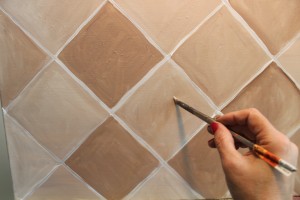How to Hand-Paint a Faux Tile Back splash
How to Hand-Paint a Faux Tile Back splash. Hand painting a tile backsplash is a quick and easy (and inexpensive!) way to add coziness to the kitchen.
Last week I painted my kitchen and the response to my faux backsplash has been incredibly positive, so I wanted to share a step-by-step tutorial with you here. How to hand-paint a faux tile back splash :
I didn’t take photos of this process while I painted the kitchen, so I recreated the process on an old canvas, but the process is the same. It’s super simple.
You will need the following supplies:
- a level (small one that fits under the cabinets and that includes a 45 degree leveling bubble if you plan to do diagonal tile)
- pencil
- primer (I used Kilz)
- craft paint (small bottles) in the colors of your choice. Don’t forget a grout color!)
- A round (pointy) paint brush (see photos below)
- A flat (rectangle) paint brush
- De-greaser and/or other cleaner
THE PROCESS
First you have to thoroughly degrease and clean the entire backsplash area. I used a TSP replacement (non-toxic version.) And then rinsed it clean and let it dry.
Next, prime then paint your entire backsplash area the most neutral color that your tile is going to be. For me, that was a mid-level beige.  Let it dry. I used acrylic craft paint so drying time was only about 15 minutes
Let it dry. I used acrylic craft paint so drying time was only about 15 minutes
Then, decide your tile layout and plan how to lay it out on your wall. For my kitchen I sat down at our kitchen island and decided which was the most visible wall. For me, that was the wall over my stove. So I decided to begin my layout there by centering a tile in the space between my stove and the hood. If your wall is near a window, be sure to mimic the exact reveal of the tiles on both sides of the window (Meaning if you have a full tile starting on one side of the window, you should have a full tile beginning on the other side too.) 
I also decided to place my tile on a diagonal It isn’t really any more challenging than a straight run of tile when you use your handy-dandy level that includes a 45 degree angle level like this. So don’t be afraid of that pattern.
Next decide the size of your tile and begin laying them out with pencil. Be sure to use a level. Don’t rely on your cabinets and walls to be level. They usually aren’t due to settling in the house. If your lines are not level, your brain will definitely see it on the wall.  Do all the lines in one directions then turn your level and do all the lines in the other direction.
Do all the lines in one directions then turn your level and do all the lines in the other direction.
Don’t skip this step. Also, be sure to add a quarter inch or so to your measurements for grout space between tiles. This is the most time-consuming part of the whole process, but oh so important! 
As an added measure, for myself, I also had a small cut out of my tile, just so I could easily double check each of my measurements without having to re-measure them. I just held the cut out up to each square. Do not think you can just trace a cut out. Your lines will go crooked and out of level. I promise.

You should end up with a wall that looks something like this. (don’t mind those flowers showing through the first layer of paint. I painted over an old canvas for this demo).
Now the fun part begins!
 If your grout lines are light colored, they will take at least 3 coats of paint to cover the pencil, so the first coat goes on those now. When they are all covered, it should look something like this.
If your grout lines are light colored, they will take at least 3 coats of paint to cover the pencil, so the first coat goes on those now. When they are all covered, it should look something like this.  That was easy, right?
That was easy, right?
 Next, for mine, I wanted to do a rustic-looking tile with slight variations in color, so I started with basic white paint and basic brown paint. And mixed them together for beige.
Next, for mine, I wanted to do a rustic-looking tile with slight variations in color, so I started with basic white paint and basic brown paint. And mixed them together for beige.
I then added a little more white to get a  different shade of beige. I also went the other direction and added a little more brown to get a darker shade of beige.
different shade of beige. I also went the other direction and added a little more brown to get a darker shade of beige.
I could go on doing as many variations as I wanted. You do what you want to do. One solid color is fine too. Especially if you are going to use a template to add a design later.
 Fill in each tile block with color. I mixed mine up just like a real tile wall–putting the colors in no particular pattern. Don’t worry about your grout lines. You will be adding a second coat to those next.
Fill in each tile block with color. I mixed mine up just like a real tile wall–putting the colors in no particular pattern. Don’t worry about your grout lines. You will be adding a second coat to those next.

So do that as soon as all your blocks have color. Second coat of grout.
Now you could stop there,  but I don’t suggest you do. The next steps are what make the tile look real. You have to add shadows and highlights. It’s quick and easy.
but I don’t suggest you do. The next steps are what make the tile look real. You have to add shadows and highlights. It’s quick and easy.
Here’s how: Just take a shade darker than the tile and add a shadow line at the bottom. I didn’t do all of mine equally because I wanted to simulate that some tiles might have set deeper into the mortar.
 So you can see that the shadow line is more pronounced on some than others.
So you can see that the shadow line is more pronounced on some than others.
I also added a highlight to some (a lighter streak at the tops where the light might hit.)
Notice how that grout is messed up again. It’s okay. Still one more coat to go on those.
 Next, step back and take note of any tile that bugs you. Go adjust it. Smooth it out, lighten or darken. Make it pretty.
Next, step back and take note of any tile that bugs you. Go adjust it. Smooth it out, lighten or darken. Make it pretty.
 Do one more coat on that grout.
Do one more coat on that grout.
And viola! 
You can come back after 30 days and apply a clear coat polyurethane on top (or two) if you want to make it shiny and scrubbable. I am going to leave mine in the un-shiny state because I like the rustic texture that it brings to my kitchen. It’s still washable, and if I ever need to touch up, it’s super simple to just take out those paints and touch up a spot or two.
Like this article? Check out the entire Kitchen makeover (to date, still may paint that table and chairs) and also our bathroom makeover as well. Also, don’t forget to like our Facebook page where we share lots of interesting and helpful posts every day! See you there.




